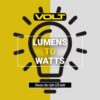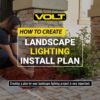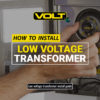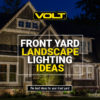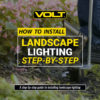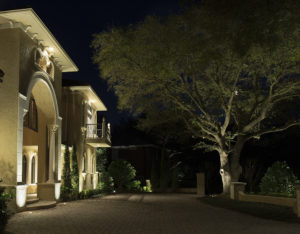 What Is Downlighting?
What Is Downlighting?
If we were given a choice, we would all light our nighttime landscape with moonlight. But since we can’t control the moon, we find another way. Downlighting is that way.
With downlights, we simulate the light of the moon. We create the feeling of moonlight. Of course, we know it’s not real, but we chose to suspend our disbelief – a term from the theater. When we immerse ourselves in a play or a film, we know it’s not real, but pretend it is – we suspend our disbelief. This is the secret of landscape lighting. We create lighting that appears to be natural, that feels natural, but is (in reality) luminaires skillfully placed and aimed.
Downlighting from Trees (Moonlighting)
Nothing is more beautiful than the dappled light effect that occurs when a fixture is mounted high in the trees allowing the light to shine naturally through branches and leaves. This is the most sought-after effect when lighting driveways, lawns, patios – really any area that needs low-level illumination. There are some key considerations before you embark on moonlighting.
- Safety
Since downlights are typically mounted 20 to 30 ft. high, they require working from a tall ladder or lift. Do not undertake the installation of these lights unless you have the right equipment, skill, and experience to work safely on a ladder. If you are a do-it-yourselfer, you may want to hire a professional to handle the mounting of your moonlights. Arborists are well equipped to work in trees, as are most landscape lighting pros. - Mounting Location
The best effect is the appearance of dappled light on the ground or hardscape area. To achieve the dappled effect, the light must project through branches and leaves. To find the best location, stand on the surface to be lit. Look up into a nearby tree to follow the trunk to about 20 ft. high. That would be the minimum height. Keep following the trunk up another 10 feet and note how many branches and leaves obscure your view of the trunk. Settle on a height and position around the circumference of the trunk that you estimate will result in the best-dappled pattern.
Note that it may not be possible to find trees with branches below 30 ft. In this case, you can still mount the lights up the trees, but the effect will be oval pools of light instead of the more desirable dappled light. This can be a nice effect, but it does look more artificial than dappled light. - Spacing
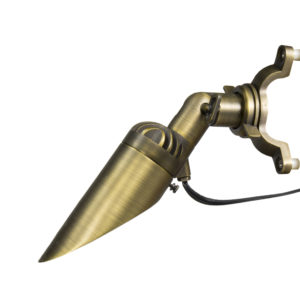 Woodsman Downlight – Available in integrated LED and lamp-ready models.
Woodsman Downlight – Available in integrated LED and lamp-ready models.If your goal, for example, is to light the length of a driveway, then you need a number of lights mounted in trees. Each light (when mounted 20 ft. high using a 60º lamp) will project an oval region of illumination with a diameter of about 20 ft. Ideally, you will use this number to plan the amount of space between the light sources. For example, an 80-foot driveway will need four lights spaced 20 feet apart. A time saver would be to mount 2 lights in each tree, one pointed to the left – the other to the right. In this example, you would only need to mount lights in two trees (spaced 40 ft. apart). The downside to that approach is that you will have light coming from two directions. This method is slightly less natural-looking than having all light pointing in one direction, which closely resembles naturally occurring moonlight.
- Fixtures & Lamps
The best fixtures for this application are the VOLT® Woodsman Downlights. These feature advanced engineering to make them easy and fast to install. They are available with LEDs integrated into the fixture body (for simplicity) or MR16 LED lamp-ready (for design flexibility). Also available, the Tree Light Management Kit includes screws, spacers, and zip ties for a clean tree-friendly way to attach fixture wire to the tree.
Downlighting from Under Gutters, Soffits, Gazebos, and Arbors
Many houses come with downlights already installed under gutters, soffits, or other overhangs. These are usually 120-volt fixtures cut into the surface and wired into the house’s electrical system. These lights typically project downward and create nice cones of light illuminating the house siding. Unless you are an electrician, you should not attempt to service or change these 120-volt fixtures.
If downlights are not already present in these locations, then you have a choice of other fixtures you can mount to the siding or underside to achieve the same (or different) effects.
- Lighting House Sidings & Garden Beds
The easiest way to illuminate the sidings on your house is using uplights – usually, spotlights stake-mounted near the base of the house. However, if you have a place to mount them, you can use downlights instead. These are best attached to the vertical wall just beneath the overhanging soffit or gutter. Some prefer the appearance of the downlight compared to the up-light. Downlights are a great way to illuminate a garden bed near the house as well. Select beam angles to achieve a wide (60º) or medium (36º) coverage depending on the size of the area being illuminated. - Lighting Gazebos and Arbors
Mounting lights in the eaves or beams inside gazebos or arbors are ideal ways to achieve comfortable low-level illumination. These fixtures are best positioned in corners or under peaks so they are mostly hidden from view. Use wide beam angles and low wattage lamps to keep the light level low while maintaining a relaxing and romantic ambiance. - Fixtures & Lamps
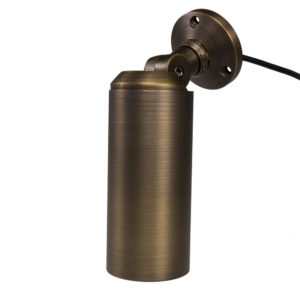
Another useful fixture is the VOLT® All-Star Tommy Light – an excellent choice for a downlight when protected by an overhang. With an attractive straight-cut housing, the fixture can be angled using the knuckle or when directed straight down. VOLT® makes other specialty fixtures that can be used creatively for downlighting applications. VOLT®’s linear LED Hardscape Lights can be hidden under gazebo eaves or railings. The VOLT® Buddy Pro is a tiny fixture that can also be hidden from view and provide widespread downlighting. Care should be taken with these fixtures that they are never within direct view of the occupants since the unobstructed LED chips are very bright when viewed directly. Other fixtures that can be used as high-performance downlights are the 12-volt LED Floodlights. However, these fixtures can be much too bright for gazebos and arbors. They can alternatively be attached to sidings or under soffits to provide bright wide area lighting. These are a great choice to replace security spotlights and for security-sensitive areas such as garage entrances.
